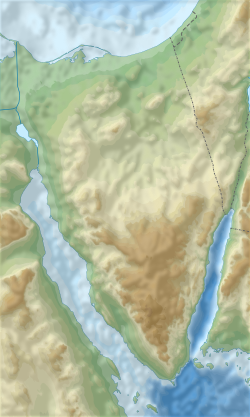Kuntillet Ajrud
كونتيلة عجرود | |
| Region | Sinai |
|---|---|
| Coordinates | 30°11′10″N 34°25′41″E / 30.18611°N 34.42806°ECoordinates: 30°11′10″N 34°25′41″E / 30.18611°N 34.42806°E |
| History | |
| Material | Stone |
| Periods | Iron Age |
| Cultures | Israelite |
| Site notes | |
| Excavation dates | 1975–76 |
| Archaeologists | Ze’ev Meshel |
Kuntillet Ajrud (Arabic: كونتيلة عجرود) is a late 9th/early 8th centuries BCE site in the northeast part of the Sinai Peninsula.[1] It is frequently described as a shrine, though this is not certain.[2]
Excavations
Kuntillet Ajrud (Arabic كونتيلة عجرود) is in north Sinai; carbon-14 dating indicates occupation in the period 801–770 BCE, and the texts may have been written c.800 BCE.[3] As a perennial water source in this arid region it constituted an important station on an ancient trade route connecting the Gulf of Aqaba (an inlet of the Red Sea) and the Mediterranean, and was in addition located only 50 kilometers from the major oasis of Kadesh Barnea.[4]
The site then known as "Contellet Garaiyeh", was identified in 1869 by Edward Henry Palmer as "Gypsaria" on the Tabula Peutingeriana: "Our own route, however, from Contellet Garaiyeh to the ruins in Lussan, was, as may be seen from the map, within a mile or so of the distance between Gypsaria and Lysa; and our discovery at the first-mentioned place of the remains of an ancient fort, renders its identity with the third station on the list more than probable."[5][6]
The site was excavated in 1975/76 by Tel Aviv University archaeologist Ze’ev Meshel, and the excavation report was published in 2012. The fortress-like main building is divided into two rooms, one large and the other small, both with low benches. Both rooms contained various paintings and inscriptions on the walls and on two large water-jars (pithoi), one found in each room.
The paintings on the pithoi show various animals, stylised trees, and human figures, some of which may represent gods. They appear to have been done over a fairly considerable period and by several different artists, and do not form coherent scenes. The iconography is entirely Syrian/Phoenician and lacks any connection to the Egyptian models commonly found in Iron Age IIB Israel art.[7][5][8]
The Kuntillet Ajrud inscriptions discovered in the excavations are significant in biblical archaeology.
See also
References
Citations
- ^ Gnuse 1997, p. 69-70.
- ^ Hadley 2000, p. 108.
- ^ Mastin 2005, p. 326.
- ^ Schniedewind 2017, p. 135.
- ^ a b Bonanno, Anthony, Archaeology and Fertility Cult in the Ancient Mediterranean, (University of Malta, 1986) pp.238ff.
- ^ Palmer: The desert of the Exodus Volume II, p.422-423
- ^ Keel & Uehlinger 1998, p. 210ff.
- ^ Bonanno, Anthony, Archaeology and Fertility Cult in the Ancient Mediterranean, (University of Malta, 1986) pp.238ff.
Bibliography
- משל, זאב; מוזיאון ישראל (ירושלים) (1978). כונתילת-עג׳רוד: אתר מקודש מתקופת המלוכה בגבול סיני [Kuntillet Ajrud: A sacred site from the royal period on the Sinai border]. Qaṭalwg / Mwzeyʼwn Yiśraʼel (in Hebrew). מוזיאון ישראל. Retrieved 2022-01-19.* Gnuse, Robert Karl (1997). No other gods: emergent monotheism in Israel. Sheffield Academic Press. ISBN 9781850756576.
- Hadley, Judith M. (2000). The Cult of Asherah in Ancient Israel and Judah: Evidence for a Hebrew Goddess. Cambridge University Press. ISBN 9780521662352.
- Keel, Othmar; Uehlinger, Christoph (1998). Gods, goddesses, and images of God in ancient Israel. Fortress Press. ISBN 9780567085917.
- Mastin, B.A. (2005). "Yahweh's Asherah, Inclusive Monotheism and Dating". In Day, John (ed.). In Search of Pre-Exilic Israel. Bloomsbury. ISBN 9780567245540.
- Park, Sung Jin (2011). "The Cultic Identity of Asherah in Deuteronomistic Ideology of Israel". Zeitschrift für die Alttestamentliche Wissenschaft. 123 (4): 553–564. doi:10.1515/zaw.2011.036. S2CID 170589596.
- Rendsburg, Gary S. (2008). "Israel Without the Bible". In Greenspahn, Frederick E. (ed.). The Hebrew Bible: New Insights and Scholarship. NYU Press. ISBN 9780814731871.
- Schniedewind, Willliam M. (2017). "An Early Iron Age Phase to Kuntillet 'Ajrud?". In Greenspahn, Frederick E.; Rendsburg, Gary A. (eds.). Le-maʿan Ziony: Essays in Honor of Ziony Zevit. Wipf and Stock. ISBN 9781498206921.
- Vriezen, T. C.; van der Woude, Simon Adam (2005). Ancient Israelite And Early Jewish Literature. Brill. ISBN 978-90-04-12427-1.
- Articles with short description
- Short description with empty Wikidata description
- Coordinates not on Wikidata
- Articles containing Arabic-language text
- CS1 Hebrew-language sources (he)
- AC with 0 elements
- Sinai Peninsula
- Archaeological sites in Egypt
- Ancient Jewish settlements
- Populated places established in the 9th century BC
- Populated places disestablished in the 8th century BC
- Yahweh
- Asherah

